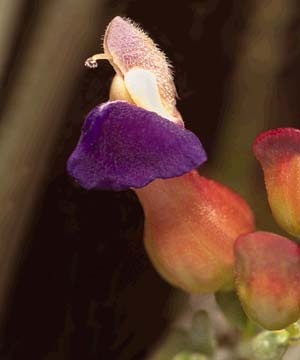The Mint Family
 |
 |
| Lamium purpureum spp.
|
Monarda citriodora spp.
|
The Lamiaceae are mostly herbs or shrubs comprising about 200 genera and 3,200 species. They
occure almost throughout the world, with the exception of the coldest polar regions. They are
particularly well represented in the tropical and temperate areas especially those with a seasonal
climate, such as the Mediterranean region and in tropical upland savannas. While some species are characteristic
of semi-arid conditions, many others are adapted to wet habitats, in seasonally flooded areas or along river
banks in forests.
Click here for a distribution map of the Lamiaceae in the U.S.A.
Vegetative Characters | Reproductive Characters |
Diagnostic Characters | Economic Importance/Fun Facts
| Evolutionary Adaptations and Relationships | Glossary of Terms |
References and Links | Pictures
- Annual or perennial herbs or shrubs (rarely woody vines or trees)
- Leaves usually simple, opposite, and decussate
- leaves serrate and exstipulate
- Stems are square when observed crossectionally
Back to top
- Plants synoecious
- Flowers perfect and zygomorphic, usually entomophilous
- Inflorescence of axillary cymes or verticils, sometimes racemiform,
peniculiform or headlike, or flower solitary
- Calyx is synsepalous with five lobes and tubular or funnel shaped
- Corolla is sympetalous, tubular and zygomorphic with five lobes
(2 upper and 3 lower)
- Usually four didynamous stamen
- Gynoecium consists of a single compound ovary of two carpels and a deeply
lobed superior ovary with four apparent locules
- Nectariferous disk is generally present between the stamen and ovary
- Fruit produces 4, one seeded, indehiscent schizocarps
<
Back to top
- Crossection of stem is square
- Pubescence of glandular hairs containing highly aromatic
ethereal oils
- Inflorescence often conjested into false whorles at the nodes
- Bilabiate sympetalous corolla
Back to top
- Economically important
- Aromatic oils of some mints are used commercially as flavoring, in pharmacology,
or in the perfume industry
- Tubers of a few species are edible
Back to top
- Monophyletic on the basis of laterally attached ovules and rbcL sequences
- Square stem is a synamorphy with Verbenaceae
- Most systematists have restricted Lamiaceae to those species with more or less gynobasic styles, a
circumscription resulting in a polyphyletic assemblagebecause gynobasic styles have evolved more than once
Back to top
- Bilabiate- two-lipped
- Decussate- four ranked, in opposite pairs alternately at right angles
- Didynamous- anterior pair of anthers longer
- Exstipulate- without stipules
Back to top
- http://www.botany.hawaii.edu/faculty/carr/lami.htm
- Judd et al., 1999. Plant Systematics: a phylogenetic approach. Sinauer Associates, Inc. Sunderland, MA U.S.A.
- http://www.rbgkew.org.uk/scihort/lamiaceae.html
- http://www.wisc.edu/botit/systematics/family_index/Family_pages_L/Lamiaceae.html
- http://www.csdl.tamu.edu/FLORA/Wilson/tfp/ast/lampage2.htm
Back to top
 |
 |
| Flower of Salazaria mexicana spp. |
Inflorescence of Monarda didyma spp. |
 |
| Pressed Monarda fistulosa spp. |
 |
| Lamiacea flowers |

Back to top
For questions or feedback, contact:
Kristopher Hamwi






